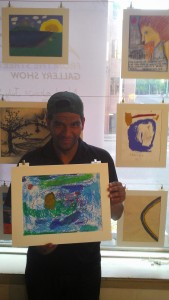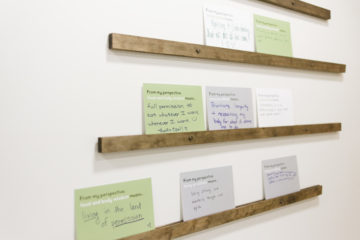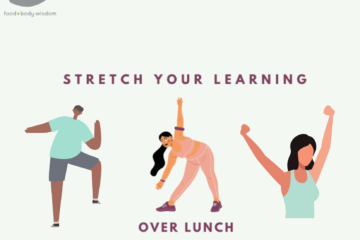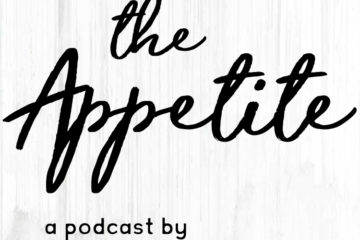[column width=”1/1″ last=”true” title=”” title_type=”single” animation=”none” implicit=”true”]
Experiential therapy for exercise eating disorder treatment through the lens of art
To begin exploring this idea of exercise and movement in eating disorder treatment, I need to give you some back story. Several years ago I had an idea. I was working at a shelter in downtown Seattle at the time with a group of people struggling with addiction and homelessness – and we were watching a lot of movies. After several months on the job I found myself beginning to sink into a cycle of depression and numbness that marked so many of our clients’ lives. I wanted to find something to inspire and enliven the community; I thought there had to be more for them, and for myself. So I decided to change things up one day and I pulled out paper, pens, pastels, watercolors, and brushes and announced to the community that we were going to have an art day instead of watching Die Hard with A Vengeance again for the fifth time in two months. I was hopeful that something of life might emerge if we pushed into it.
The idea seemed perfect in theory but I quickly found it was nearly impossible to get everyone out of their routines, even if that routine consisted of merely staring at a wall for three hours before dinner. I got all kinds of different responses to my invitation but, ultimately in a room full of artistic possibilities, very few clients felt free to make art. Most did not believe that they were “creative” or that anyone would want to see their art. Something about my invitation seemed to brush against an inner pain, a deep sense of self-criticism and self-hatred inside of them.
In the midst of this reality, however, there were a few men and women who had the audacity to join me. I had big plans for this small contingent in the beginning. Although I was not conscious of it at the time, I felt an inner responsibility to make this gathering into something more than just making art. I wanted them to get better and progress, both as artists and as people. My hope was that they would change and heal and in my mind that had everything to do with what they did. I tried to force things towards that end and grew more and more frustrated at the members of the community who did not participate. I began noticing that the more I forced them towards my hope, the more I ended up making art alone. So instead of trying to manipulate everything, I eventually started paying attention to what the clients chose to create. There were stick figures, mountains, rivers, houses, happy faces, curse words, poems, flowers, boats. There were colorful, dark, mysterious, and terrifying masterpieces. They were all different and unique. Each beautiful in their own way. Most importantly though, as I learned to put down my own distractions and look closely, I found inside these art pieces the precious breadcrumbs of each person’s story. The images of their past experiences and the colors of their longings and fears. Each canvas willingly offered what so few were used to finding in their relationships; a safe space for their true voice.
Suddenly, each piece of art was not “good or bad”, it was telling. The more I focused on what was instead of what I thought should be, the more I found myself captivated by each unique artist and their way of communicating their lives truth. Placing a judgement on a piece only served to separate me further from the faces and truths being declared. In the end, it was this journey into this deeper truth that became the point. Instead of blocking these stories with a judgement we learned that healing could only come when we were allowed to finally speak the unspeakable. To honor our voice and story in a way that might finally make sense of all the confusing scenes and characters.
Now you might be asking yourself, “What does art therapy have to do with exercise and sport?” Great question. My job now as an Experiential Therapist for clients struggling with eating disorders at Opal is to help them begin to explore and understand their relationship to sports and exercise, and the lessons from art therapy years ago are actually still relevant to my work today. At Opal, we don’t just talk about the relationship to exercise and sport, we actually make room for it to speak. I often frame this exploratory process with clients through the analogy of painting, which so deeply impacted me years before. Sport and exercise is merely a canvas that has the ability to open a space for us to communicate. Therefore, my work with clients is not primarily to arrive at some new place, but to listen together to the impulses, compulsions, emotions, and behaviors that emerge as we move, play, and exercise together. The goal is not to judge the movement, but to make room for the experiences that clients long to convey through their movement. With this developing posture, our hope is to provide the very thing that was so often lacking in clients’ formative years – a safe space to process what feels confusing, incongruent, and scary.
What I always find is that nobody does what they do for no reason. What each client “paints” on the canvas of sport and exercise actually makes sense of the experiences of their life. Often times, the very places we try to cover up in shame are the places that shine a light on the path towards freedom in recovery from an eating disorder.
So, it is from this posture of listening and acceptance that we are able to dispel the grip of shame and begin experimenting with new ways of being…and doing. If we aren’t being distracted with what should be we can begin to make peace with what has been and move towards a new world of possibilities. The heart of this process is ultimately rooted in each client beginning to love and honor their body and its experience more expansively. The more they are able to accept that they are worthy of care and attunement, the more the possibilities for movement, exercise, and sport begin to expand and transformational recovery becomes more possible. Their desire in movement once again becomes merely a reflection of the changing world inside of them. More flexible, more free, more playful, more alive.
It is in this spacious place that we can allow the weight of judgement and shame to fall away so we can begin to enjoy the rich feast of possibilities open before us. Maybe here we can feel free to enter into movement and tell a new story.
– Knox Burnett, LMHCA
[/column]




0 Comments